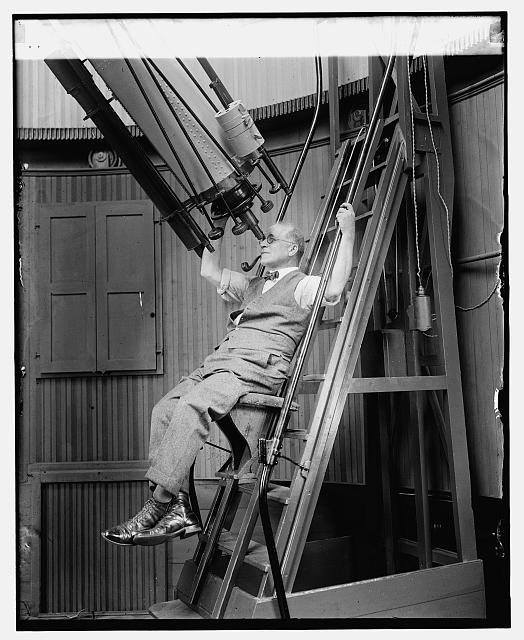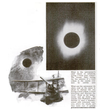“What can the astronomer do, when, just as the moon is about to obscure the sun during a total eclipse, a cloud intervenes?” Popular Science posed such a dilemma to its readers in a 1919 solar eclipse story. “Pack up and go home” was the answer for the average eclipse viewer. But even in 1919 extreme eclipse chasers had contingency plans.
The moon’s full shadow hurtles across the Earth at a breakneck 1,500 mph roughly every 18 months. By a twist of cosmic fate unique in our solar system, our planet’s one and only moon happens to be the right size and distance to completely block the sun’s face, briefly exposing its corona, creating a spectacular sight. But that complete overlap only happens in a narrow path about 100 miles wide—the path of totality.
Extreme eclipse chasers, who call themselves umbraphiles, will seek that path whenever it comes around, even to the remotest regions of Earth. Since the path carved by the moon’s shadow typically traverses thousands of miles—across oceans and continents—the goal is to pick a destination known for its cloudless skies.
Kelly Korreck, NASA’s program manager for the 2024 solar eclipse, which will speed across the US from Texas to Maine on April 8, has viewed eclipses from places as different as the deck of a US aircraft carrier (USS Yorktown) and the northern Chilean coast. For Korreck, the experience is incomparable. “Very strong emotions come up,” she says, “from almost fear that the sun has gone away to something very magical and very exciting.” As soon as it’s over—totality only lasts several minutes or less, location dependent—she admits that her immediate thought is, “When’s the next one? Where are we going to go?”
 Dr. David Todd at the Georgetown Observatory on Aug. 21, 1924. Image: Library of Congress
Dr. David Todd at the Georgetown Observatory on Aug. 21, 1924. Image: Library of Congress
In 1919, jetting across the world was not yet possible, and less of the planet was developed and accessible. Eclipse chasers were mostly well-funded scientists and astronomers who had the wherewithal to mount an expedition, set aside months for travel, and haul tons of equipment into remote regions. That’s why one astronomer’s plan in 1919 to mount a telescope on a seaplane and fly above the clouds seemed worth reporting, even though Popular Science’s editors were skeptical that it would work. The alternative, “unmanned balloons” fitted with cameras, proposed by George Hale, founder of the Mount Wilson Observatory in California, seemed much more practical.
Whether the daring aeronautical astronomer, David Todd, an eccentric eclipse chaser and erstwhile professor at Amherst College, ever succeeded with his seaplane plan isn’t recorded. But the 1919 eclipse went down in the history books for its role in providing the backdrop for Arthur Eddington and Frank Dyson to prove Einstein’s theory of relativity.
Today, NASA operates dozens of heliophysics missions, most from space-based observatories, free from the chance of cloudy skies.

A total eclipse of the sun can never last more than eight minutes. Usually it lasts much less. An astronomer will travel thousands and thousands of miles to an out-of-the-way place, in order to make the most of a few precious minutes. The actors in a play are no more carefully rehearsed than are astronomers stationed at the various instruments. No one member of an eclipse expedition sees the eclipse as a whole; each one performs the special duties assigned to him.
What if cloud or fog should steal between the earth and the sun? What if it should rain? All these elaborate preparations, all this tedious traveling, go for nothing. But fogs are always low-lying—never more than a thousand feet thick. Therefore, if cloud or fog creep in between the earth and the sun, the solution is to climb above them and see the eclipse in all its uncanniness.
No wonder, then, that astronomers are interested in the experiment undertaken by Professor David Todd, of the Amherst College Astronomical Observatory, of using a seaplane in which to rise high above the clouds to view the eclipse.
Professor Todd’s Experiment
With the assistance of United States Naval officers and a seaplane, Professor Todd set out to take photographs of the sun’s eclipse which occurred on May 29. It was planned that the steamship on which the expedition sailed would stop at a point near the equator off the South American coast, launch the seaplane, and then stand by while the astronomer tried out his plan.

It might have been expected that Professor Todd would be the first to carry astronomy into the air. He is the most enthusiastic, indefatigable, and ingenious of eclipse observers. He even went so far, some years ago, as to devise a method of operating a whole battery of astronomical instruments from a central point, but was unable to employ his invention for the observation of this particular eclipse because the sky was at the time obscured.
Although at the time of going to press the results of Professor Todd’s experiment have not been reported, it may be doubted that the plan of using a seaplane is practicable. Such is the vibration caused by a seaplane’s engine that the steady platform that must be provided for all telescopes becomes a shaking base hardly suitable for Professor Todd’s purpose. To be sure, it was his intention to offset the vibration by an elastic mounting of the telescope; but anyone who knows anything at all about the inertia of movable parts will admit that absolute steadiness can hardly be thus obtained.
A More Practical Scheme
Professor George E. Hale, of Mount Wilson Observatory, has a far more practical scheme, to our mind. His plan is to send an unmanned balloon above the clouds, and to steady the cameras, which the balloon will carry, by means of a gyroscope. Professor Hale plans to study the corona—that ghostly appendage which surrounds the sun, and which is visible from the earth only during an eclipse—at any time.
As we ascend in the atmosphere of the earth we finally reach a point, perhaps at an altitude of thirty miles or more, where the sky is not blue, but jet-black.
The sky is blue because the air is filled with countless billions of dust particles that diffuse the light of the sun. In the inky canopy of the sky above the region of dust particles, where the air is extremely thin, the stars appear in their proper places even in broad daylight. And the sun is a great blazing ball hung in the blackness. Its wonderful corona, the chief object of study during a total eclipse, gleams in all its pearly beauty.
Should Professor Todd Succeed
If Professor Hale succeeds in realizing his plan, we need not wait for a total eclipse in order to study the corona but we can photograph it whenever we please and study it day by day.
>>> Read full article>>>
Copyright for syndicated content belongs to the linked Source : Popular Science – https://www.popsci.com/science/1919-eclipse-chasers/































